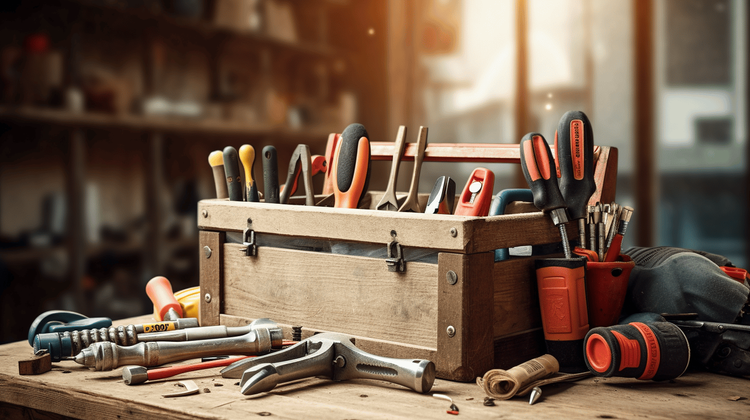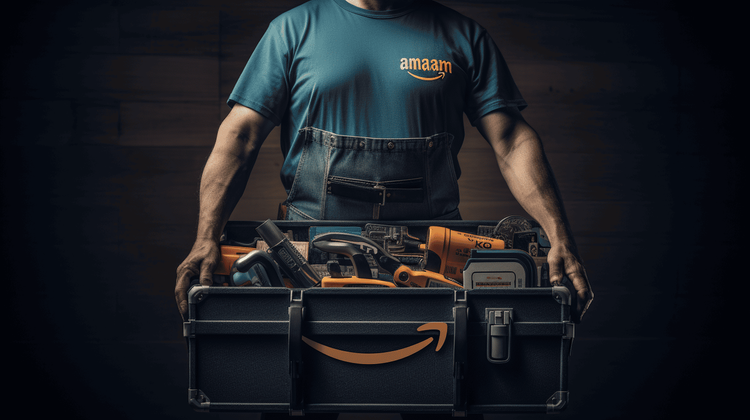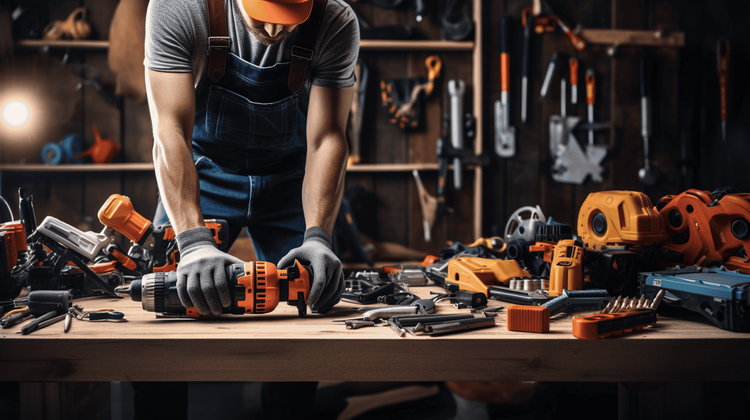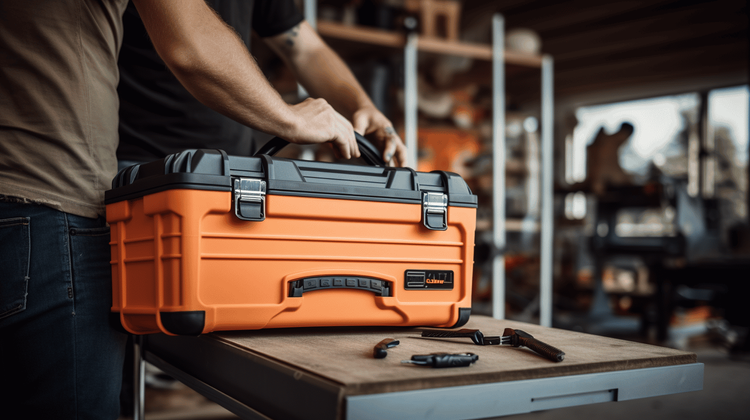Revolutionary Low-Cost Tools for Your Next DIY Project

Welcome, fellow DIY enthusiasts! In the magical world of Do-it-Yourself projects, our imagination is the limit. Whether you're a seasoned DIY veteran or someone who's just starting on their home makeover journey, you've landed in the right place! Grab that steaming cup of coffee and brace yourselves as we delve into the subject of DIY tools - a crucial component for any project.
From simple and cost-effective tools to the absolute essentials for every DIY task, this guide has got you covered. We'll highlight the benefits of these versatile tools, demonstrate how they can save you money, and even lift the curtain on vendors offering the best deals. Plus, we'll take a quick detour into the realm of safety - because, as every DIYer knows, a safe project is a successful project!
In our subsequent sections, you'll find a wealth of tidbits that will make your DIY endeavors a truly stress-free experience. So dust off your creativity - it's time to explore the exciting world of low-cost DIY tools! 🛠️✨🔩
Why DIY Projects?
Stepping into the world of do-it-yourself (DIY) projects opens a door to a magical realm where creativity runs wild, and the satisfaction derived from personal accomplishments reigns supreme. Let's not forget about the sizable savings that come with it! Whether it's redecorating a room, knitting a new sweater, or fixing-up the backyard, DIY projects come with a host of benefits that extend far beyond just saving a few pennies. Let's dive into some of these perks.
Saving Money 🤑
Needless to say, taking on a DIY project can save a decent chunk of your hard-earned cash. When you opt for DIY, you're not just paying for materials - you're also eliminating the middle-man costs associated with labor, handling, and all those other hidden fees. Creating a budget and sticking to it can further enhance your savings. Here's a quick budgeting breakdown:
- Material Cost: This is the amount spent on raw materials.
- Tool Cost: If you're starting fresh, you may need to buy the necessary tools. Consider it an investment, as you'll be using these for future projects.
- Time Investment: Your time is valuable! Consider the hours you'll be devoting to your project.
Learning New Skills 🔨🎨
There's so much more to DIY projects than meets the eye. Besides honing your handiness around the house, these endeavors empower you to acquire new skills that could potentially blossom into a passion or hobby. Turn woodworking into a calming weekend retreat, transform unused spaces with interior designing hacks, or unleash your inner artist with funky wall art. As you navigate and conquer different DIY projects, you’ll find each new skill learned as a compelling addition to your life's toolbox.
Self-Satisfaction 🥇
This success can't be bought – it's a high that comes from seeing your vision turn into reality, constructed by your own two hands. The joy of personal achievement when you've successfully completed a task is an unparalleled feeling. This isn't about competing with others, but rather watching as your capability and confidence grow with each project.
"Nothing is quite as satisfying as doing it yourself!"
Whether you're looking to save money, learn new skills, or simply experience the joy of creating something with your own hands, diving into DIY projects can be an immensely enriching journey. Why not check out our recent DIY project ideas to kick-start your DIY adventure?
Remember, there's more to DIY than crafting - it's about learning, growing, and above all, enjoying the process! 🚀
Understanding Essential DIY Tools
Do-it-yourself, more commonly known as DIY, has seen an enormous popularity surge in recent years. Perhaps you want to do a quick repair around the house, or maybe you're interested in taking on a larger project. Either way, it's essential to be properly armed with the necessary tools. This article aims to help you understand the basic DIY tools you should own.
Portable Toolkit
Getting to grips with a portable toolkit can be a great place to start. Aptly named for its compact size and the ability to carry many essential tools, an amateur handyman (or woman!) would find a portable toolkit extremely beneficial. Inside, you could find:
- A hammer 🔨 - useful in various situations, from hanging a picture to disassembling furniture.
- Screwdrivers – A common part of any toolkit for a good reason.
- Pliers – Great for pulling, bending, or cutting wires.
- Tape measure 📏 - because accuracy is vital in DIY.
Remember, the most important aspect of a toolkit isn't its size or the number of tools but the versatility they provide.
Building and Construction Tools
Whether you're diving head-first into a home renovation or merely creating a little shelf, building and construction tools are your best friends. You might want to consider adding:
- A saw – A hand saw is adequate for small projects, but a power saw can be worth the investment for larger tasks.
- Drill – For all the screwing and unscrewing demands.
- Level – Used to ensure alignment is maintained.
- Safety goggles, gloves, and hats - because safety should never be compromised.
Electrical Tools
Embarking on an electrical project requires not just knowledge but also specialized electrical tools. An assortment of wire strippers, voltage testers, and electrical tape are common inclusions to ensure that your circuits are safe and properly wired.
Painting Tools
Whether it's to add a splash of color to a room or just a touch up, you'll need painting tools. Brushes and rollers are common, but don't forget to consider:
- Extension poles – To reach high walls or ceilings.
- Paint trays – It keeps paint easily accessible.
- Drop clothes 🎨 - to keep your furniture clean and paint-free.
Gardening Tools
For green thumbs (or those aspiring to be), gardening tools are a must. A basic set includes a trowel, pruning shears, and a watering can🌺. More advanced tools, like lawn aerators and pruning saws, may come in handy as well.
When you have a better understanding of the tools at your disposal, your DIY projects will come together more quickly and efficiently. So gear up and let your creativity run wild with these must-have DIY tools. Happy crafting!
Cost-Effective DIY Tools
Looking to become an expert Do-It-Yourself enthusiast or just trying to make sure that leaky faucet does not become a problem? A collection of cost-effective DIY tools could be your best friend! Here's a guide to help you on this adventure of becoming a savvy savant, without burning a hole in your pockets.
Multipurpose Tools
One does not need to break the bank to acquire a full range of DIY tools. The trick is to pick tools that serve multiple purposes:
- Adjustable Wrenches: This versatile tool can replace an entire range of wrench sizes. Whether it's for plumbing or basic woodwork, an adjustable wrench is a must-have.
- Cordless Drill: Need to poke a hole or fasten a bolt? You guessed it, a cordless drill comes to the rescue. Plus, it's extremely portable.
- Multipurpose Screwdriver: Instead of juggling between multiple screwdrivers, invest in a multipurpose variant with interchangeable heads.
Discounted or Used Tools
Why buy new when you can get perfectly good tools at discounted rates or even used ones? Garage sales, second-hand stores, or online marketplaces often offer fantastic deals.
Rent Instead of Buy
Heavy-duty or specialty tools that are rarely used do not necessarily need to be bought. Renting these could prove to be extremely cost-effective. In addition to this perk, renting also saves one the hassle of finding stowage space.
Quality vs. Cost
Finally, while cost-effectiveness is key, quality should not be compromised. A cheap tool that falls apart after a few uses is no bargain. Find a balance between cost-effectiveness and durability. Remember, these are investments.
Building a collection of cost-effective DIY tools can seem like a daunting task at first, but by focusing on multipurpose, discounted, and rented items of good quality, you'll have a capable toolkit in no time. After all, Rome wasn't built in a day, and neither is a practical toolkit. 👍
Vendors of Low-Cost Tools
Investing in the right tools is vital for any project, business, or creative pursuit. In today’s bustling marketplace, a multitude of vendors are selling low-cost tools that are both reliable and affordable. While many might have the notion that these budget-friendly options may cut corners on quality, that's not always the case.
Today, we're here to dive into the world of cost-effective tools and the vendors that sell them.
Emerging Market of Low-cost Tools
Over the years, there has been a drastic shift in the tool-selling industry. It's important to remember that not all tools have to burn a hole in your pocket.
Featuring:
- High-end functionality: These tools aren’t just cheap in their price, but they offer the same level of performance as their pricier counterparts.
- Wide range of choices: Options are limitless. Whether you’re a DIY-enthusiast looking for a new drill bit, or a professional crafter in need of a top-notch sewing machine, there's a vendor out there with a deal for you.
- User-friendly designs: These tools are designed keeping the end-user in mind. They're typically easy to handle, with intuitive designs that won't leave you scratching your head.
These aspects highlight the immense value that low-cost tools can bring to the table. Don’t be skeptical - purchasing these tools doesn’t mean you're trading functionality for affordability.
Credible Vendors and Their Offerings
With the increasing demand for cost-efficient tools, numerous vendors have stepped up. They're continually striving to offer good-quality, economical options for both amateurs and professionals.
- Harbor Freight: A trusted name in the business, Harbor Freight provides a broad array of tools catering to various fields. They consistently offer sales and discounts, encouraging savings for their customers.
- Home Depot: Known for their home improvement goods, Home Depot stocks an impressive selection of value-for-money tools, perfect for any DIY project.
These vendors, among others, are continually striving to balance the scales in favor of affordability, without compromising on quality. It's their commitment to the customer that sets them apart.
The Takeaway
Quality doesn't always have to come with a steep price tag and finding a vendor that aligns with this idea might take some time and research, but it's well worth the effort. Remember that a tool's effectiveness is inherent in the way it's used, not its price. After all, a truly skilled craftsman never blames their tools.
So, why not opt for a tool that gives you a bang for your buck? It's not just about saving money, it's about making smart investments that pay off in the long run.
Safety Considerations for DIY Tools
DIY projects can be incredibly satisfying, enabling you to accomplish tasks with your own two hands, besides saving you from expensive professional services. On the flip side, potential risks accompany this empowerment. When it comes to DIY tools, safety can't be emphasized enough: their improper usage or inadequate maintenance can lead to severe injuries. In this section, we'll dissect safety considerations that are paramount when using DIY tools, including proper usage, maintenance and storage, and the significance of protective gear.
Proper Usage
Foremost is the prudent usage of DIY tools. It's indeed tempting to embark on your project the moment your shiny new tool arrives. Resist that urge™️ and invest some time understanding its functionality. Let’s break down some guidelines to help you:
- Read the manual: These instructive guides may not be as thrilling as a bestselling novel, but they do hold essential information about safe and effective tool operation.
- Right tool for the right job: A hammer should not become a substitute for a drill. Using tools for unintended purposes escalates risks of damage and injury.
- Adjust handling based on power: Different tools require different handling techniques. For example, an electric drill requires a firm grip and careful maneuver, while a paintbrush calls for a softer touch.
Maintenance and Storage
The way you maintain and store your tools can also impact their safety level. Lackluster maintenance can lead to malfunctions, creating hazardous situations. Here are some tips to ensure your tools are always in top condition:
- Regular cleaning: Tools should not be packed away dirty. Ensure they are thoroughly wiped down after use to prevent rusting and minimize wear and tear.
- Annual servicing: Some tools may require more than a superficial clean. It’s in your best interest to get these tools serviced annually to keep them running smoothly.
- Proper storage: Tools should be stored securely to prevent them from falling and inadvertently injuring someone. Toolboxes or storage cabinets are ideal for this purpose.
Protective Gear
Lastly, but just as importantly, comes the role of protective gear. No matter how safe you feel, don't start your project without wearing adequate protective gear. Here's why:
- Eye protection: Flying debris can result in serious eye injuries. Safety glasses and goggles are your friends—don’t neglect them.
- Hand protection: DIY projects often require working with sharp or rough objects. Invest in durable, snug-fitting gloves to keep your hands safe.
- Hearing protection: Some tools produce a detrimental level of noise. Protect your hearing by using earplugs when using such tools.
“Safety first” should always be a mantra when working with DIY Tools. By respecting your tools and using them correctly, maintaining them well, and protecting yourself, you can ensure that your DIY projects remain a joy rather than becoming a danger.
Conclusion
Life is an ongoing journey filled with the constant search for growth, self-discovery, and self-fulfillment. The DIY movement plays an essential role in this process with its cost-effectiveness, educative aspects, and immense personal satisfaction.
From learning new skills to saving money, doing your DIY projects is a whimsical joy ride. But for the adventure to be safe and productive, it's vital to make wise choices when it comes to your DIY toolkit. Opt for quality tools that provide versatility and durability. Used, discounted, or rented tools can further help keep costs low.
Take special care of safety measures. Ensure proper usage of tools, regular maintenance, and always remember to don your protective gear before diving into the world of DIY.
Where can you find such a range of quality yet cost-effective tools, you ask? Ultra Handy. Our Bit Holder Keychain for screwdriver bits is a best-seller, thrown into the mix of various other hand tools and supplements aimed to help active people maintain their health.
Subscribe now to Ultra Handy and become part of our DIY enthusiasts' federation. Discover the healing power of accomplishing projects with your own hands and the satisfaction of practical, tangible success.
Until next time, keep reaching out for the tools, gear up for your next DIY adventure, and keep creating. Just remember, safety first! Happy building.
Frequently Asked Questions
- What are some revolutionary low-cost tools for DIY projects?Some revolutionary low-cost tools for DIY projects include: 1. Cordless drill/driver, 2. Multi-tool, 3. Laser measurer, 4. Electric paint sprayer, and 5. Digital angle finder.
- Are low-cost tools as effective as expensive ones for DIY projects?While low-cost tools may not always offer the same durability or advanced features as expensive ones, they can still be highly effective for most DIY projects. Consider your specific needs and the duration of your project before investing in tools.
- Where can I find affordable tools for my DIY projects?You can find affordable tools for your DIY projects at various places such as online marketplaces like Amazon and eBay, local hardware stores, thrift stores, and garage sales. It's always good to compare prices and read reviews before making a purchase.
- What factors should I consider when choosing low-cost tools for DIY projects?When choosing low-cost tools for DIY projects, factors to consider include the quality and durability of the tool, user reviews, warranty or return policy, versatility, and compatibility with your specific project requirements.
- What are the benefits of using low-cost tools for DIY projects?The benefits of using low-cost tools for DIY projects include cost savings, accessibility, and the ability to complete simple to medium-level projects without investing in expensive tools. Low-cost tools can be a great option for occasional DIYers or beginners.




